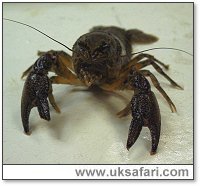
|

|
|
 Sent
to you Sent
to you
by e-mail
|
|
Simply
enter your details and hit the send button
more
info |
|


Click Here

Links
Advertise
Terms of Use
Contributors
About Us
Contact Us
|
 |
Go back
 | Bookmark
| Bookmark
 | Print Page
| Print Page  | E-Mail Us
| E-Mail Us 
 
 Photo: The Environment Agency
Photo: The Environment Agency
|
|
UK
Safari Tip:
Crayfish can generally be found hiding under large stones and rocks during
the day.
|
|
Latin name: Austropotamobius pallipes
Size: Grows to around 10cms.
Distribution: Rare. Confined mainly to a few streams and lakes in the
north. Cumbria is a stronghold for this species.
Months seen: All year round
Habitat: Streams, rivers and lakes.
Food: Snails, aquatic insects and small fish
Special features: Crayfish are relatives of the lobster, and have five pairs of walking legs. The front pair feature large pincers for catching prey.
They can be found under rocks or in holes in the bank.
There is more than one species of crayfish in Britain.
In 1970 the American Signal Crayfish (Pacifastacus
lenusculus) was introduced to the UK for the restaurant trade.
Our native White-Clawed Crayfish, as the name suggests, has a creamy-white or peach colouring under the
claws. These native British crayfish breed from the age of three-four years. The
females produce up to 200 eggs, and the young hatch between May and June.
The invasive American Signal Crayfish can be identified by bright red colouring under the claws and white patches on claw joints.
They can breed from the age of one, and the females produce up to 500 eggs. The young hatch
between April and May. They are more aggressive than our native crayfish.
 The Signal Crayfish takes over the territories of our native species
and also carry the 'crayfish plague', a deadly fungal disease which has virtually wiped out our native
White-Clawed Crayfish. The Signal Crayfish takes over the territories of our native species
and also carry the 'crayfish plague', a deadly fungal disease which has virtually wiped out our native
White-Clawed Crayfish.
Signal crayfish dominate in the south and east of the country. In the last decade, native crayfish
strongholds have shrunk towards the north.

UK Safari Freshwater Section
|
 |

|